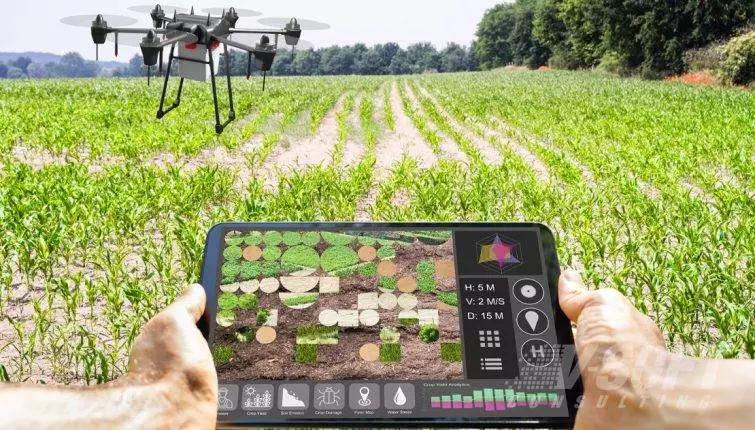Farming and Agriculture are the most crucial and significant professions in the world. Both the professions are assets for our country’s growth! Isn’t it? Especially in a country like India, Agriculture is the prime occupation of the majority of the people.
As per the statistics, the global population will reach nine billion by 2050, which automatically leads to an increase in the demand for food. To fulfill the food demand, agriculture production must increase by 70%. Folks, in the article, you will know about How AI and Machine learning play an important role in the Agriculture sector.
Applications of AI and Machine Learning
The success of any sector or industry is dependent on endless factors, one of which is effective decisions. If we specifically talk about agriculture, many factors affect decision-making. Factors like climate change, soil conditions, crop specifications, etc. Our farmers have to give priority to one thing over another too regularly. Isn’t this a tough situation for farmers?
But thankfully, innovation has given birth to artificial intelligence and machine learning (ML). Farmers now can easily grow more production by using advanced data and analytics tools. It will enhance the farming type, improve efficiencies, and eliminate waste in food production and biofuel. On the other hand, AI and ML have minimized the negative impact on our environment.
Throughout the globe, the agriculture sector is one of the powerpack industries, with a $5 trillion turnover. Spending on ML and AI technologies has proved to be the best decision for the agriculture sector. The prediction says the Agriculture sector will rise to $ 4 billion in 2026 with the highest CAGR of 25.5%.
Folks, the article will provide you knowledge about ML and AI applications that will revolutionize the Agriculture sector. Check out the four major categories:
Crop Management
Sophisticated ML techniques are the savior for Farmers. The techniques assist farmers to predict and detect crop diseases. Harvest yields, check out the crop quality, and identify the type of plant species.
Yield Prediction
What is critical for the farmers is to match the market demand with the crop supply! MI-powered techniques like support vector machines ( SVM), a powerful ML model that helps in rice farming, help in yield mapping and estimation. Farmers have a golden chance to use ML as part of agriculture management, where they can use agrichemicals inputs on affected crops.
Crop-Quality Evaluation
For agricultural products, prices go up and down, farmers have to identify the quality of the crop and its features. By using MI techniques, the farmers can detect and reveal the crop’s overall quality.
Plant Species Identification
AI and ML machines automatically check out the plant species.
Livestock Management
Livestock management means managing livestock production and animal welfare. ML and AI technologies have worked in favor of Livestock management, by working in various areas like animal health maintenance, dairy production, herding, and selective breeding.
Animal Welfare
Animal welfare means disease detection of animals and checking their behavior. With the help of ML technologies like video cameras, you can easily trace animal activities around the farm. ML-powered techniques like a halter, collar and ear tag sensors help farmers to collect data and monitor animal behavior.
Live Stock Production
ML has been the reason for the success behind the Livestock production. The farmers can predict and estimate the farming parameters in watching out the production of eggs, milk, meat, and dairy products. For example, farmers can check the weight of a five months bull on the day of slaughter day, by this farmers get an opportunity to take care of the living and diet of bulls.
Field Conditions Management
Soil Management
Agriculture experts with ML and AI approaches can understand the worth of soil properties. Via ML algorithms that experts can know the soil moisture, temperature, evaporation processes, etc.
Species selection
Species selection is tough. It involves a long process for detecting water effectiveness and nutrients usage. Via AI and ML techniques, farmers can resist species diseases. Farmers can analyze the chunks of field data to lookout the crop performance under different weather conditions. Via analyzing the data, farmers can predict the specific genes.
Species Recognition
You can easily classify the plant by looking at its shape and leaf color. Via MI, farmers can analyze the leaf vein morphology and tell farmers about leaf properties using aerial imagery.
Challenges for the Agriculture Sector by 2050
There are two important challenges :
As per the UN reports, the world population will increase by 2 billion by 2050, which means the global food system needs to provide food to extra people.
By 2050, many factors can cause problems in harvesting like climatic factors, global warming, heatwaves, water shortages, rising sea levels, pesticides, etc.
ML and AI techniques can bear the above challenges. Agriculture experts have to work with AI and ML approaches. ML can boost agriculture productivity while saving the environment from negative impacts.
Conclusion
ML and AI is the secure way of enhancing agricultural productivity. Through the data collected from ML techniques, the farmers can know the crops, their genes, potential diseases, etc. This data will act as a second hand to the farmers and help them make quick decisions. ML is the ultimate solution for the farmers’ issues about food security and scarcity.

